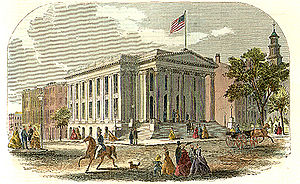
Back Britse en Amerikaanse maateenhede Afrikaans Sistema anglosaxón d'unidaes AST Angloamerikanisches Maßsystem BAR Англійская сістэма мер Byelorussian Ангельская сыстэма мераў BE-X-OLD Sistema anglosaxó d'unitats Catalan Angloamerická měrná soustava Czech Angloamerikanisches Maßsystem German Usona-angla mezur-unua sistemo Esperanto Sistema anglosajón de unidades Spanish

Governments were one of the earliest users of weights and measures – often for the purpose of tax collection. In the United States the US Treasury rather than Congress took the lead in establishing a standard system of weights and measures.
The imperial and US customary measurement systems are both derived from an earlier English system of measurement which in turn can be traced back to Ancient Roman units of measurement, and Carolingian and Saxon units of measure.
The US Customary system of units was developed and used in the United States after the American Revolution, based on a subset of the English units used in the Thirteen Colonies; it is the predominant system of units in the United States and in U.S. territories (except for Puerto Rico and Guam, where the metric system, which was introduced when both territories were Spanish colonies, is also officially used and is predominant).[1] The imperial system of units was developed and used in the United Kingdom and its empire beginning in 1824. The metric system has, to varying degrees, replaced the imperial system in the countries that once used it.
Most of the units of measure have been adapted in one way or another since the Norman Conquest (1066). The units of linear measure have changed the least – the yard (which replaced the ell) and the chain were measures derived in England. The foot used by craftsmen supplanted the longer foot used in agriculture. The agricultural foot was reduced to 10⁄11 of its former size, causing the rod, pole or perch to become 16+1⁄2 (rather than the older 15) agricultural feet. The furlong and the acre, once it became a measure of the size of a piece of land rather than its value, remained relatively unchanged. In the last thousand years, three principal pounds were used in England. The troy pound (5760 grains) was used for precious metals, the apothecaries' pound, (also 5760 grains) was used by pharmacists and the avoirdupois pound (7000 grains) was used for general purposes. The apothecaries and troy pounds are divided into 12 ounces (of 480 grains) while the avoirdupois pound has 16 ounces (of 437.5 grains). The unit of volume, the gallon, has different values in the United States and in the United Kingdom – the US fluid gallon being about 0.83 imperial gallons and the US dry gallon being about 0.97 imperial gallons. The US fluid gallon was based on the wine gallon used in England prior to 1826.
After the United States Declaration of Independence the units of measurement in the United States developed into what is now known as customary units. The United Kingdom overhauled its system of measurement in 1826, when it introduced the imperial system of units. This resulted in the two countries having different gallons. Later in the century, efforts were made to align the definition of the pound and the yard in the two countries by using copies of the standards adopted by the British Parliament in 1855. However, these standards were of poor quality compared with those produced for the Convention of the Metre. In 1960, the two countries agreed to common definitions of the yard and the pound based on definitions of the metre and the kilogram. This change, which amounted to a few parts per million, had little effect in the United Kingdom, but resulted in the United States having two slightly different systems of linear measure – the international system, and the surveyors system.
- ^ "US leaves the world puzzled by dragging its feet on metric system". The Nation Thailand. 26 December 2015. Retrieved 28 January 2023.